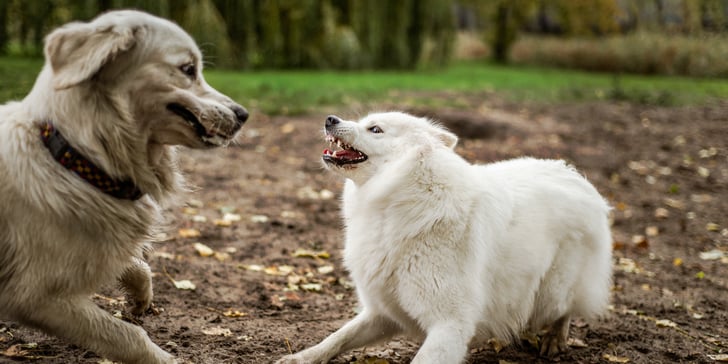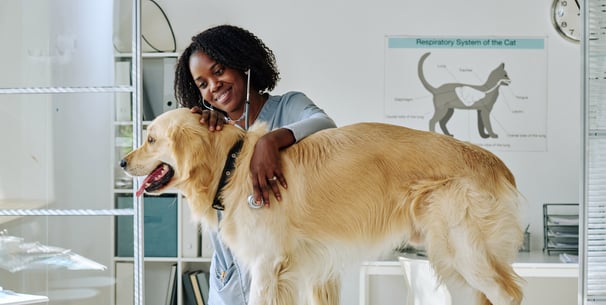Why Are My Dog’s Ears Back? - Canine Body Language
Index:



Introduction
You notice your pet walking around with ears back, and worry creeps in—are they scared, hurt, or anxious?
This uncertainty can make you feel guilty: are you missing signs of fear or nervousness or ignoring a call for help?
No need to panic. We’re here to break down the position of your dog’s ears and how it fits into body language as a whole.
We’ll share reasons why dogs put their ears pinned or pulled back, along with practical tips to help your dog feel more secure.
Key takeaways:
If your dog’s ears are back, it can be a sign that a dog is cautious, worried, or excited
Reading a dog’s body language involves watching the rest of their posture, like a tail wag or a crouch
Dogs also pin their ears due to illness or injury, so a closer look is vital
Dogs use facial expressions and ear posture to communicate with you and other dogs
A dog will put their ears in different positions based on how they’re feeling (happy, nervous, or playful)
Instead of punishing an anxious dog, offer reassurance or consider a certified dog behaviour expert
Understanding your dog’s signals can strengthen your bond and create a comfortable environment for your dog.



Understanding our dog’s ears and what they’re saying
There are common reasons why dogs hold their ears pinned or flat against their head.
Sometimes, a dog is anxious or nervous around unfamiliar people.
Other times, your dog may just want to show submissive behaviour to bigger dogs.
Ears can tell us so much about how a dog is feeling. When a dog puts their ears back, it might be caution, curiosity, or fear.
Pair that with a wagging tail or avoiding eye contact to understand the bigger picture. Each dog has a natural ear shape—some have floppy ears, while others have more upright ears.
So, always consider the different ear shapes when interpreting dog ear signals.
Check out our article 'What Your Dog’s Barks Mean' for another angle on communication. Pairing ear signals with vocal clues gives a clearer insight into your best friend’s emotions.



Common dog ear positions (and what they might mean)
Ears forward, upright
If your dog’s ear position is forward or perked up, you can assume they are curious about something.
They might be interested in a sound or a sight. Sometimes they’ll move their ears from forward to mid-position if they’re not sure yet how to react.
One ear up and one ear down
Ever see one ear up and one ear flopped down? This can be unique to each dog. Some dogs are just built that way, especially with dogs with pointy ears or long ears.
Also, some breeds' ears come to attention at different times.
While not a standard warning sign, it’s essential to check for ear infections or even ear mites if your dog suddenly changes how they position their ear.
Ears pinned back
When a dog’s ears are back—especially if pressed flat against their head—they could be uncertain, anxious, or wanting to show they’re submissive to another dog.
A dog in a total crouched stance with ears pinned is typically a nervous dog.
You might notice the whites of their eyes (often called whale eye), a pant, or a slight tail wag low to the ground if they’re worried.
To learn about stress signals, explore our article 'Dog Panting at Night: Reasons Why'. Recognising nighttime panting can be another clue to your pup’s anxious habits.



Ear positions and possible interpretations
Remember, the rest of their body language plays a big role in clarifying your dog’s emotional state.
A high, wagging tail can mean excitement, but if they tuck their tail, it could signal fear.



Reasons why dogs put their ears back
1. Fear or nervousness: A dog feels threatened or spooked by a loud noise or new environment—ears are back can happen instantly.
2. Submissive greeting: If your dog is greeting another dog or a human they perceive as an authority, they might pin their ears briefly.
3. Illness or injury: An illness or injury (like ear infections) could lead your dog to hold their ears back. Always observe for scratching or whining.
4. Listening: Sometimes, your pup simply angles its ears back to better catch a sound behind them.
For broader insights on health watch-outs, read 'Why Are Dogs’ Noses Wet?'- it details interesting dog health tidbits that might help if your pup’s habits suddenly change.
Aimee the vet says:
"Just as we can often tell how our pets are feeling, they will read our body language and tone of voice too. It is really important for them to feel calm that we are calm around them. Use a positive, confident tone of voice to help them relax. If we are stressed and anxious, they will be too!”



Reading the rest of your dog’s body language as a whole
Tail signals
A slow, low wag can indicate caution. A tail wag that’s big and sweeping with the dog’s bum wiggling?
That’s likely a happy dog.
Meanwhile, a stiff or tucked tail points to an anxious dog.
Keep track of how your dog’s ears move in harmony with their tail.
Facial expressions
Dogs also show worry with a furrowed brow, whale eye, or extended yawn. They might pin their ears if they’re uncertain.
Meanwhile, a gentle, open mouth or “smile” can mean your dog is happy.
If they sense a threat, you might see lips curling or baring teeth—this is an aggressive body language cue.
Body stance
Observe if your dog stands tall or crouches. A confident stance with a relaxed posture usually means your pup is at ease.
A lowered chest, ears pinned, and avoiding eye contact? That’s your dog telling you they’re uncomfortable.
Looking at these cues together helps you understand your dog’s world.



Practical tips for helping a dog whose ears are back
1. Give space: If your dog’s ears go back and they tuck their tail, they might want room to breathe.
2. Offer calm words and body: Speak gently, avoid leaning over them, and let them approach you.
3. Encourage a safe environment: Provide a cosy corner or crate where your dog can unwind without feeling threatened.
4. Check for health issues: If your pup’s ears come up only halfway or remain pinned for days, a quick vet check can rule out illness or injury like ear infections.
Many training principles can be adapted to any breed, focusing on building confidence instead of punishing.



What to do if you notice negative changes
Consult a professional dog trainer
A certified dog behaviourist or dog trainer can interpret the subtle nuances of your pup’s training and behaviour.
Sometimes, a few friendly sessions help an anxious dog become a happy dog again.
If your dog always tenses around specific triggers (like fireworks or strangers), professional coaching can help them relax.
Rule out medical concerns
If your dog’s ears are back constantly, especially along with a reluctance to move or changes in eating habits, contact your vet.
They can test for ear mites, ear infections, or other health-related pain signals. Early detection ensures your dog is not silently suffering.
For additional tips on caring for your furry friend’s well-being, have a look at our article 'Understanding Dog Sleeping Positions'. Sleep posture can also reveal comfort or distress, adding another piece to the puzzle.
Use positive reinforcement
When your dog trusts you, they’ll position their ears freely—often forward or relaxed. That’s why rewarding calm behaviour with treats or praise fosters a better environment.
Dog training thrives on clarity and kindness, so a consistent approach pays off.



Having insurance helps
At the end of the day, we all want our dog to feel confident and loved.
Understanding our dog’s ear signals is just one step toward building a stronger connection.
If unexpected medical issues arise, consider exploring Waggel Pet Insurance to provide an extra safety net.
Because when your dog is healthy and cared for, you can both focus on the joyful parts of life—like that unstoppable wag and plenty of cuddles.
Conclusion
Every dog is unique, from their ear posture to the subtle ways they express excitement or nervousness.
A dog puts their ears back for reasons spanning from polite submission to genuine fear.
A dog's ears back does not always mean trouble, but paying attention is key to making your pup feel secure. We encourage you to watch the rest of their body language.
When in doubt, consult a vet—and remember that with patience, empathy, and a tailored plan, your best friend can thrive with their ears up, down, or anywhere in between.
Waggel Pet Insurance
Need more help? You're in luck if you're a Waggel Pet Insurance member. Along with our excellent coverage, we offer access to a 24/7 online vet to answer all your sticky questions, especially if you need grooming assistance.
Not a member? Why not get a quote now and cover your furry friend for a range of illnesses, all while enjoying our amazing perks and rewards.
Want more like this?
Get updates from us with helpful info, advice, answers to frequently asked questions and much more.
Index:
- Introduction
- Understanding our dog’s ears and what they’re saying
- Common dog ear positions (and what they might mean)
- Ear positions and possible interpretations
- Reasons why dogs put their ears back
- Reading the rest of your dog’s body language as a whole
- Practical tips for helping a dog whose ears are back
- What to do if you notice negative changes
- Having insurance helps
- Conclusion
Related posts:
Get your quote
Along with our excellent coverage, we offer access to a 24/7 online vet to answer all your sticky questions.





